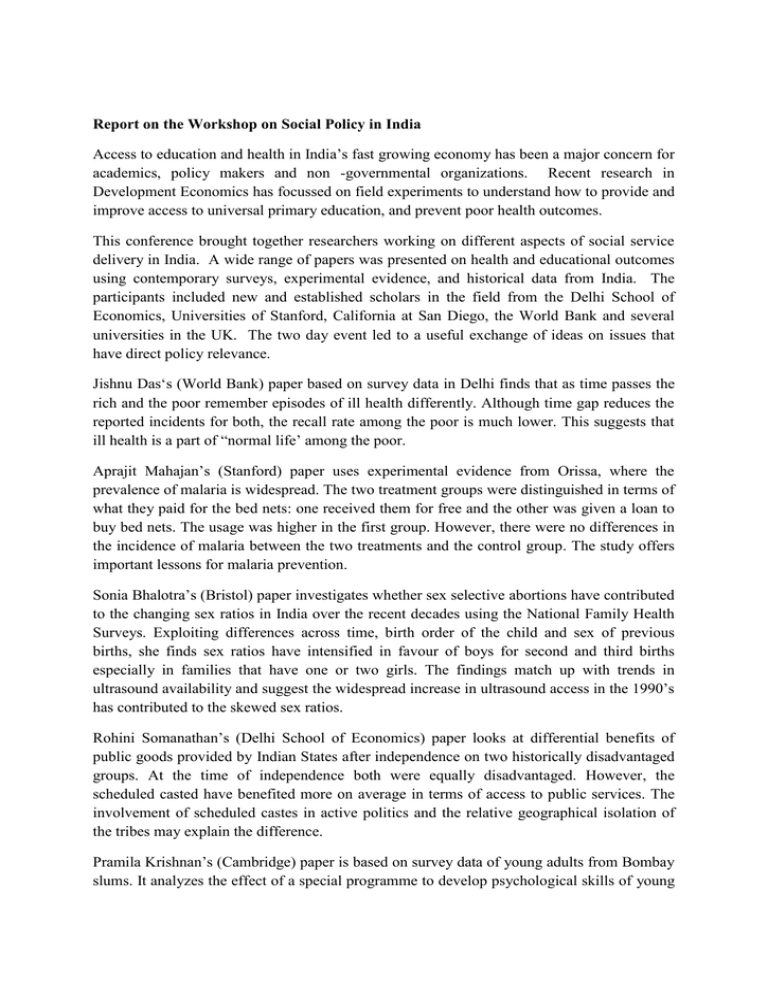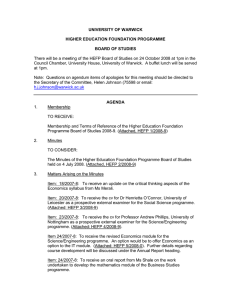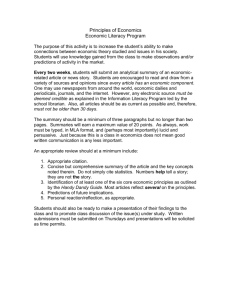Access to education and health in India’s fast growing economy... academics, policy makers and non ... Report on the Workshop on Social Policy in India
advertisement

Report on the Workshop on Social Policy in India Access to education and health in India’s fast growing economy has been a major concern for academics, policy makers and non -governmental organizations. Recent research in Development Economics has focussed on field experiments to understand how to provide and improve access to universal primary education, and prevent poor health outcomes. This conference brought together researchers working on different aspects of social service delivery in India. A wide range of papers was presented on health and educational outcomes using contemporary surveys, experimental evidence, and historical data from India. The participants included new and established scholars in the field from the Delhi School of Economics, Universities of Stanford, California at San Diego, the World Bank and several universities in the UK. The two day event led to a useful exchange of ideas on issues that have direct policy relevance. Jishnu Das‘s (World Bank) paper based on survey data in Delhi finds that as time passes the rich and the poor remember episodes of ill health differently. Although time gap reduces the reported incidents for both, the recall rate among the poor is much lower. This suggests that ill health is a part of “normal life’ among the poor. Aprajit Mahajan’s (Stanford) paper uses experimental evidence from Orissa, where the prevalence of malaria is widespread. The two treatment groups were distinguished in terms of what they paid for the bed nets: one received them for free and the other was given a loan to buy bed nets. The usage was higher in the first group. However, there were no differences in the incidence of malaria between the two treatments and the control group. The study offers important lessons for malaria prevention. Sonia Bhalotra’s (Bristol) paper investigates whether sex selective abortions have contributed to the changing sex ratios in India over the recent decades using the National Family Health Surveys. Exploiting differences across time, birth order of the child and sex of previous births, she finds sex ratios have intensified in favour of boys for second and third births especially in families that have one or two girls. The findings match up with trends in ultrasound availability and suggest the widespread increase in ultrasound access in the 1990’s has contributed to the skewed sex ratios. Rohini Somanathan’s (Delhi School of Economics) paper looks at differential benefits of public goods provided by Indian States after independence on two historically disadvantaged groups. At the time of independence both were equally disadvantaged. However, the scheduled casted have benefited more on average in terms of access to public services. The involvement of scheduled castes in active politics and the relative geographical isolation of the tribes may explain the difference. Pramila Krishnan’s (Cambridge) paper is based on survey data of young adults from Bombay slums. It analyzes the effect of a special programme to develop psychological skills of young adults. Difference in difference estimates show that those who attended developed higher aspirations relative to others from a similar social background. Marco Alfano and Wiji Arulampalam’s (Warwick) paper on the impact of female autonomy of children’s educational attachment find positive and statistically significant effects on child enrolment in India using the NFHS data of 2005/06. The effect is pronounced in Northern India, which has lower female autonomy on average. Sarmistha Pal (Brunel) presented a paper on the impact of private schools in India. Using a district-level panel data-set for the period1992-2002 the paper finds a significant positive impact of private school growth on literacy while its effect on gender gap in literacy remains rather weak. The effect of literacy is stronger among 10-14 year old children, who were the first generation to benefit fully from the private school growth. Karthik Muralidharan’s (San Diego) paper uses experimental evidence from Andhra Pradesh on the impact of using contract teachers in primary schools that are not professionally trained. This programme has been controversial. The evidence suggests a positive effect on learning outcomes in maths and language, especially in remote areas. The contract teachers are less likely to be absent and are paid less than regular civil service teachers. Latika Chaudhary’s (Scripps College) paper studies the effects of colonial public educational investments on post independence outcomes across the districts of former British India. She finds that 1911 public spending continues to influence literacy up to 1991, but after accounting for the potential endogeneity of spending the effects are significant up to 1971. The findings point to the success of government programs implemented in the 1970’s to reduce inequalities in the provision of public services. A panel discussion with Latika Chaudhary (Scripps College), Stephan Dercon (Oxford University) Maitreesh Ghatak (LSE) commented on the research agenda on social service delivery in developing countries. The conference was funded by CAGE and Warwick Economics Department and organized by Bishnupriya Gupta (University of Warwick) and Latika Chaudhary (Scripps College and visiting fellow at the Institute of Advanced Studies at Warwick)




